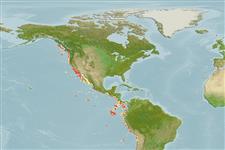Environment: milieu / climate zone / depth range / distribution range
Ecology
Marine; bathypelagic; depth range 225 - 1400 m (Ref. 96339). Deep-water; 55°N - 23°S, 135°W - 70°W
Eastern Pacific: off British Columbia, Canada (Ref. 12204), and from Washington, USA (48°N) to Chile (23°S) (Ref. 35760).
Size / Weight / Age
Maturity: Lm ? range ? - ? cm
Max length : 25.0 cm SL male/unsexed; (Ref. 96339)
Short description
Identification keys | Morphology | Morphometrics
Usually near coasts (Ref. 12204). Oviparous, with large mesopelagic larvae (Ref. 35760).
Life cycle and mating behavior
Maturity | Reproduction | Spawning | Eggs | Fecundity | Larvae
Coad, B.W., 1995. Encyclopedia of Canadian fishes. Canadian Museum of Nature and Canadian Sportfishing Productions Inc. Singapore. (Ref. 12204)
IUCN Red List Status (Ref. 130435: Version 2024-2)
Threat to humans
Harmless
Human uses
Tools
Special reports
Download XML
Internet sources
Estimates based on models
Preferred temperature (Ref.
123201): 3.8 - 5, mean 4.7 °C (based on 19 cells).
Phylogenetic diversity index (Ref.
82804): PD
50 = 0.5020 [Uniqueness, from 0.5 = low to 2.0 = high].
Bayesian length-weight: a=0.00407 (0.00154 - 0.01080), b=3.17 (2.94 - 3.40), in cm total length, based on LWR estimates for this (Sub)family-body shape (Ref.
93245).
Trophic level (Ref.
69278): 3.4 ±0.5 se; based on size and trophs of closest relatives
Resilience (Ref.
120179): Medium, minimum population doubling time 1.4 - 4.4 years (Assuming tmax>3).
Fishing Vulnerability (Ref.
59153): Low vulnerability (21 of 100).
